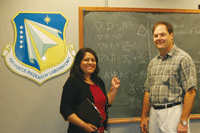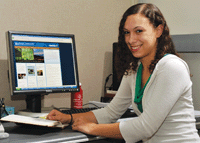Making Summer Count: Student Interns Get a Jump on Careers in Math/Computing
August 1, 2009

Analee Miranda and her AFRL/RF Systems and Analysis Branch mentor Joe Tenbarge discuss Maxwell�s equations and the wave equation. From the Air Force Research Laboratory, Wright�Patterson AFB.
Michelle Sipics
With the end of summer in sight, Rensselaer Polytechnic Institute math professor Margaret Cheney has a message for students: Start thinking now about next summer.
Cheney's message is directed to students in math and computer science---graduate and undergraduate---who are interested in internship and co-op opportunities. For many summer 2010 programs, she points out, applications must be completed this fall. Over the years, Cheney (whose work in imaging, in particular on synthetic aperture radar, is well known in SIAM circles) has guided many of her students to rewarding internships with the Department of Defense and its contractors. There are plenty of internships out there, she says, but in many cases students know nothing at all about them.
"Unfortunately there seems to be little awareness among students and faculty advisers about internships," she says. "This may be a vicious circle: Faculty who didn't themselves do internships may not realize how valuable they are, and don't know about the opportunities."
Through their experiences, she says, her own students have demonstrated the benefits of such opportunities: "They get exposure to different sorts of working environments, they get to see firsthand the critical role of mathematics in important real-world problems, and they learn that it's important to be able to communicate with people with different technical backgrounds. The personal contacts they make during an internship can also be very helpful in their careers.
"And finally, they usually have a lot of fun, and return to school much more motivated and excited about their studies." Cheney mentions a current graduate student who recently began a summer internship with a DoD contractor; the student has already contacted her to discuss future coursework related to what he's been doing in his internship.
The Department of Defense has several programs for students at all levels, from high school all the way through graduate and professional degree programs. Participants in the Student Career Experience Program (SCEP), for example, work flexible schedules, either full- or part-time, in the fields they are studying. In addition to gaining experience while completing their degrees, SCEP students can become eligible for full-time, permanent employment after graduation.
DoD also offers the Summer Student Contract Program (SSCP), under which students take 10- to 12-week co-op positions or internships with DoD contractors in their fields of study.
As a beginning graduate student, Analee Miranda, who is working on a PhD in mathematics under Cheney's supervision, did an internship with the SET Corporation, a defense contractor in Arlington, Virginia. Miranda thought that she might be interested in radar imaging; on Cheney's recommendation, she applied for the internship to find out whether she wanted to work in the field.
As it turns out, she does: Radar imaging is the subject of her dissertation, thanks in part to her internship experience. At SET, Miranda worked on the CounterBomber project, a radar system designed to detect the presence of hidden explosives under clothing. The first version of the product is currently being used in Iraq to detect suicide bombers; Miranda worked with a SET team trying to reduce the size of the unit and improve the system's resolution.
"I was an analysis intern," she explains, outlining her myriad responsibilities: "helping with the experiments and data collection, organizing the data, creating presentations, writing code, analyzing information, surveying academic literature to find new methods that would help with radar imaging, focusing, and analysis of the images created.
"I was able to use and strengthen my basic coding skills, and my analytical skills were constantly challenged by the diversity of duties I had," Miranda says. "I learned that I liked this field of research and, more importantly, that mathematicians can greatly contribute to [it]."
Like Cheney, Miranda encourages students to seek out internships and other ways to work in their chosen fields before graduation.
"Not only do they gain experience they can add to their resume, but they get to figure out what type of jobs they like and don't like," says Miranda, who expects to complete her PhD in the spring of 2011, and who is now doing another internship---this time at the Air Force Research Lab in Dayton, Ohio.
Heather Palmeri, an applied mathematics major who completed her undergraduate degree at RPI this year, spent last summer as an intern at the Air Force Research Lab in Rome, New York. A student in RPI's accelerated BS/PhD program, Palmeri says that the greatest benefit of the internship was getting a chance to put what she had learned in her math classes to use.

Heather Palmeri, an applied mathematics major who completed her undergraduate degree at RPI this year in an accelerated BS/PhD program, spent this summer and last interning in research laboratories and gaining real-world experience. From MIT's Lincoln Laboratory.
"As a math major, I have been asked countless times, �What can you do with math?'" she says. "[I] didn't really know for a while. I knew I liked it, but I didn't know how I could ever actually use it in the real world. Working at AFRL was hands-on and I got to see exactly how what I was doing applied in real life. The experience you get by having an internship is very different than what you get by just taking classes alone."
Palmeri recalls the work she did, mainly in the lab's Radar Frequency Tomography Chamber, which is designed to reconstruct images of targets placed on a turntable in the middle of the chamber. Transmitters send out electromagnetic waves at known frequencies, she explains; some are absorbed by the foam padding of the chamber, but some bounce off the target and return to the receiver.
Using Fourier transforms, the researchers transform the receiver data from the frequency domain to the time domain; they can then determine exact distances between the walls of the chamber and the edges of the target. With these distances in hand, they can reconstruct an image of the target. Throughout the internship, Palmeri used MATLAB, familiar to her from her academic coursework, to analyze data from the chamber.
In addition to her MATLAB skills, "Much of the mathematics behind the data [analysis] I was doing had come from previous classes I had taken," Palmeri says. "It's a chance to see how what you're learning will be used later in life." Palmeri is doing another internship this summer, at the Massachusetts Institute of Technology's Lincoln Laboratory at Hanscom Air Force Base.
The list of DoD internships available to both undergraduate and graduate students is extensive (see the sidebar on page 5 for a list of just some of the opportunities available). Along with individual internships at private companies are programs like the Air Force Institute of Technology's Excellence in Engineering & Science Summer Internship. AFIT, the Air Force's graduate school of engineering and management, accepts undergraduates (U.S. citizens only) in this program (known as E2S2I), giving them the opportunity to work on research projects at the graduate level. The interns are encouraged to consider graduate study at AFIT (located at Wright�Patterson Air Force Base) in the future.
Taking the idea a step further is the DoD-wide Science, Mathematics, and Research for Transformation (SMART) scholarship, which was established to bring more civilian scientists and engineers to DoD labs. The scholarships are open to both undergraduate and graduate students and include full tuition payments as well as yearly cash stipends and summer internships at DoD facilities for multi-year participants. On graduation, recipients are required to work in civilian DoD jobs, with the length of the commitment depending on individual scholarships.
Similarly, the Awards to Stimulate and Support Undergraduate Research Experiences (ASSURE) program was designed to encourage undergraduate research in fields relevant to DoD, with the eventual goal of increasing the number of science and engineering majors pursuing graduate degrees. Under the ASSURE program, which is run jointly with the National Science Foundation's Research Experiences for Undergraduates program, 60 participating research universities together host about 500 students each year. ASSURE has a narrower focus than SMART, being designed primarily for science and engineering majors who do not attend major research universities; ASSURE students do not incur a service obligation. The program currently receives about $4.5 million in annual funding.
The programs described here represent a small sample of available opportunities. We hope that student readers, inspired by the experiences of Cheney's students, will look for programs tailored to their own levels and goals, whether through DoD or through other organizations that provide student internships.
Michelle Sipics is a contributing editor at SIAM News.
Internship Opportunities
The following programs are some of the main sources of internship and research experiences available through the Department of Defense. Students are encouraged to consider these opportunities, and to explore additional internship possibilities on their own. Further information about programs and resources geared to students can be found on the SIAM student home page at http://www.siam.org/students/.
Department of Defense Student Summer Contract Program (SSCP)
http://www.whs.mil/HRD/Apply/SpecialEmployment/StudentEmploymentPrograms/StudentContract.cfm
DoD Student Career Experience Program (SCEP)
1 (888) 363�4872
[email protected]
http://www.go-defense.com/internships.html
Live chat with a career counselor: http://www.go-defense.com/info.html
ASSURE Program
Undergraduate research experience with no service obligation.
List of ASSURE-supported sites, with research topic and contact info:
http://www.nsf.gov/crssprgm/reu/list_result.cfm?unitid=10023
SMART Scholarship
Undergraduate and graduate scholarships with post-graduation civilian service requirement.
http://www.asee.org/fellowships/smart/
Federal Government-wide Student Job Search
http://www.studentjobs.gov/
National Security Agency Student Opportunities
Undergraduate and graduate positions, including summer programs in computer science, cryptologic access, and mathematics; co-op programs for electrical/computer engineering and computer science students; and scholarship information.
http://www.nsa.gov/careers/opportunities_4_u/students/
Air Force Institute of Technology E2S2I Program
For undergraduate students (U.S. citizens only). Graduate-level research performed with faculty and grad students. Contact AFIT's Office of Research and Sponsored Programs for more information: (937) 255�3633.
http://www.afit.edu/en/enr/research.cfm?a=contact
Office of Naval Research Enterprise Intern Program (NREIP)
Ten-week summer research internships for graduate and undergraduate students in various Navy laboratories.
http://nreip.asee.org/
Army Educational Outreach Program
Research, education, internship, and co-op opportunities, including Gains in the Education of Mathematics and Science (GEMS) summer Army laboratory internships, Career Related Experience in Science & Technology program (CREST) summer and/or part-time employment in the Army Intern Program, Consortium Research Fellows Program (CRFP) undergraduate and graduate research placements, and more. Information about specific programs can be found under Programs�College/Career Development at http://www.usaeop.com/aeop.htm.

